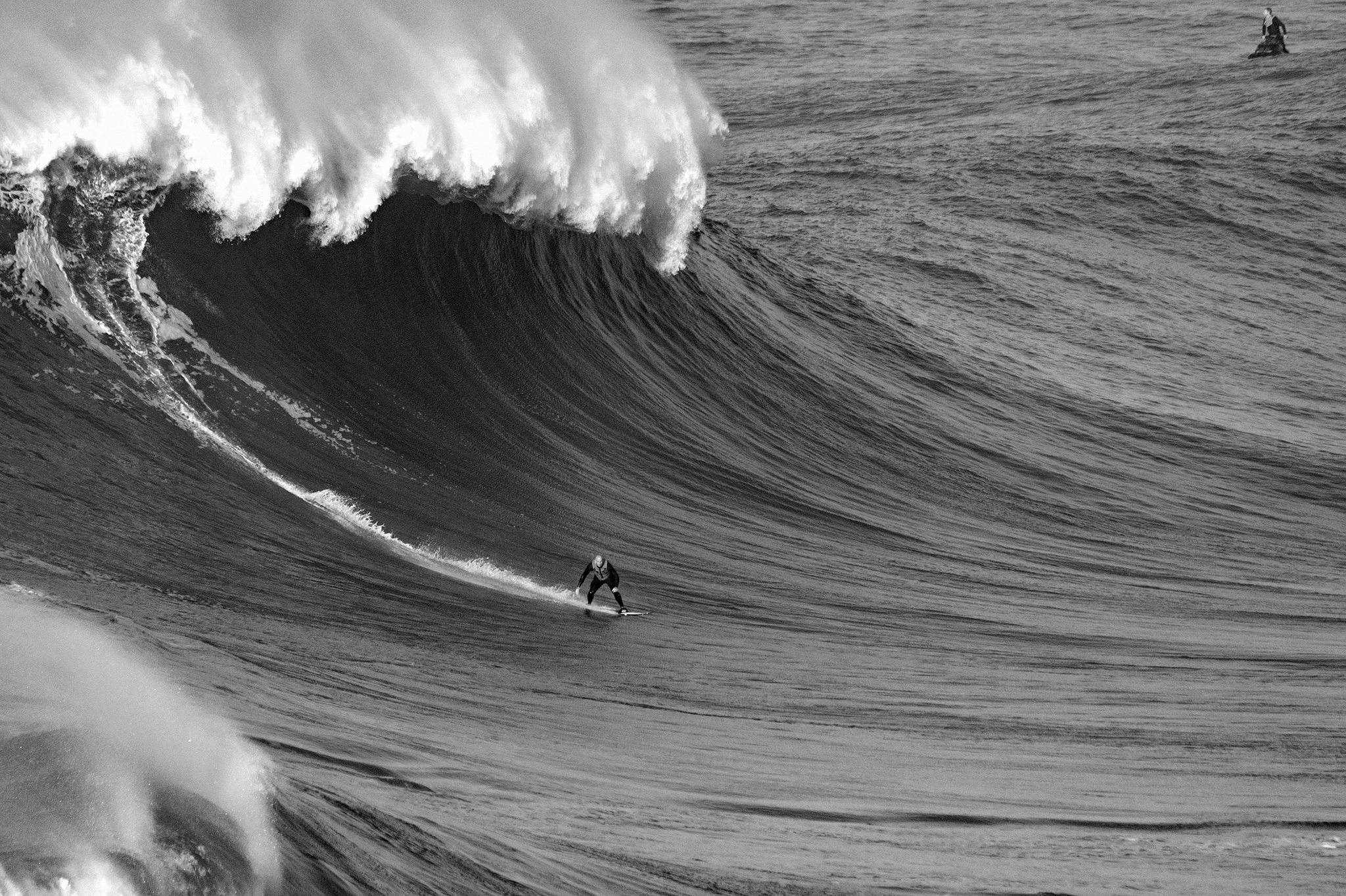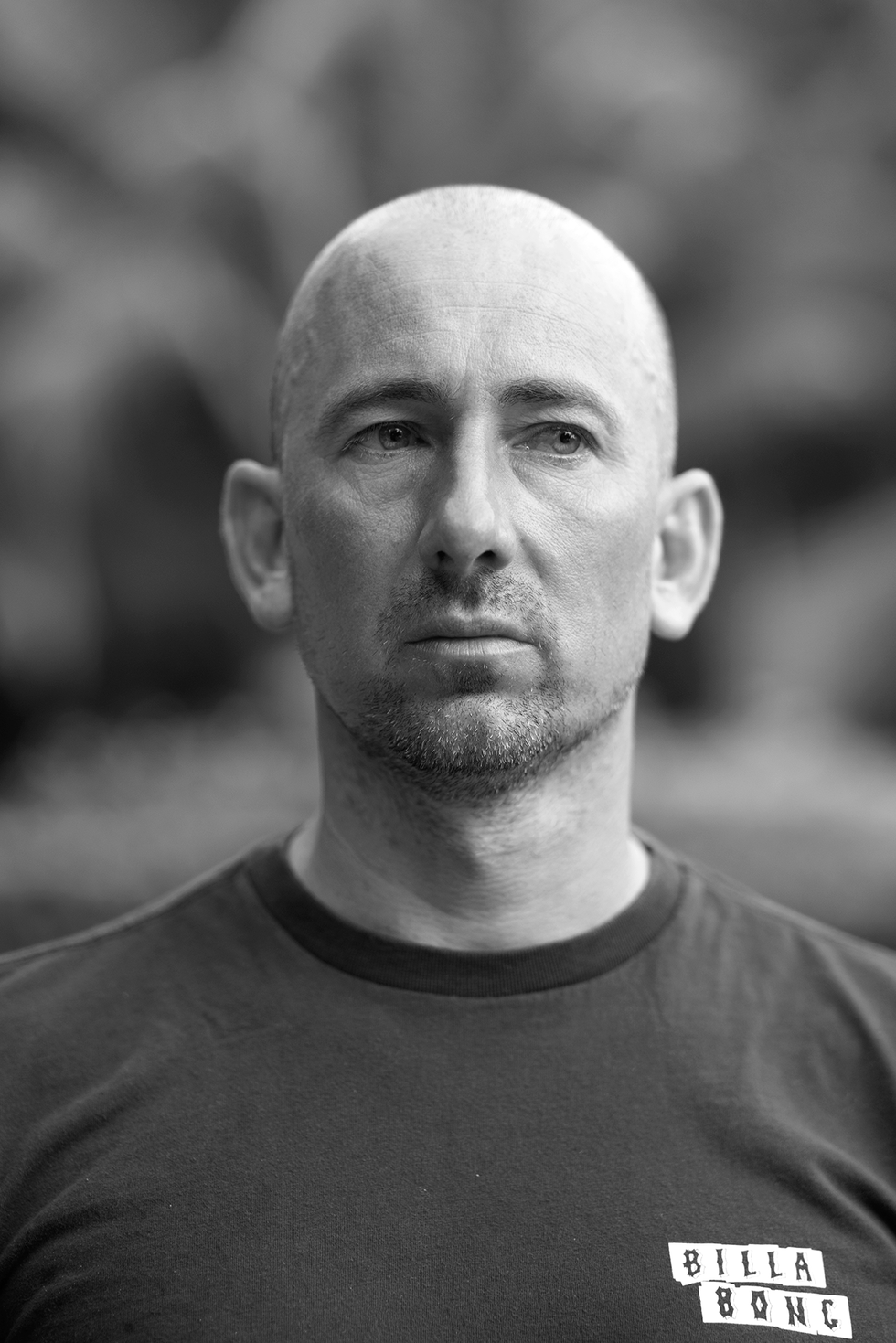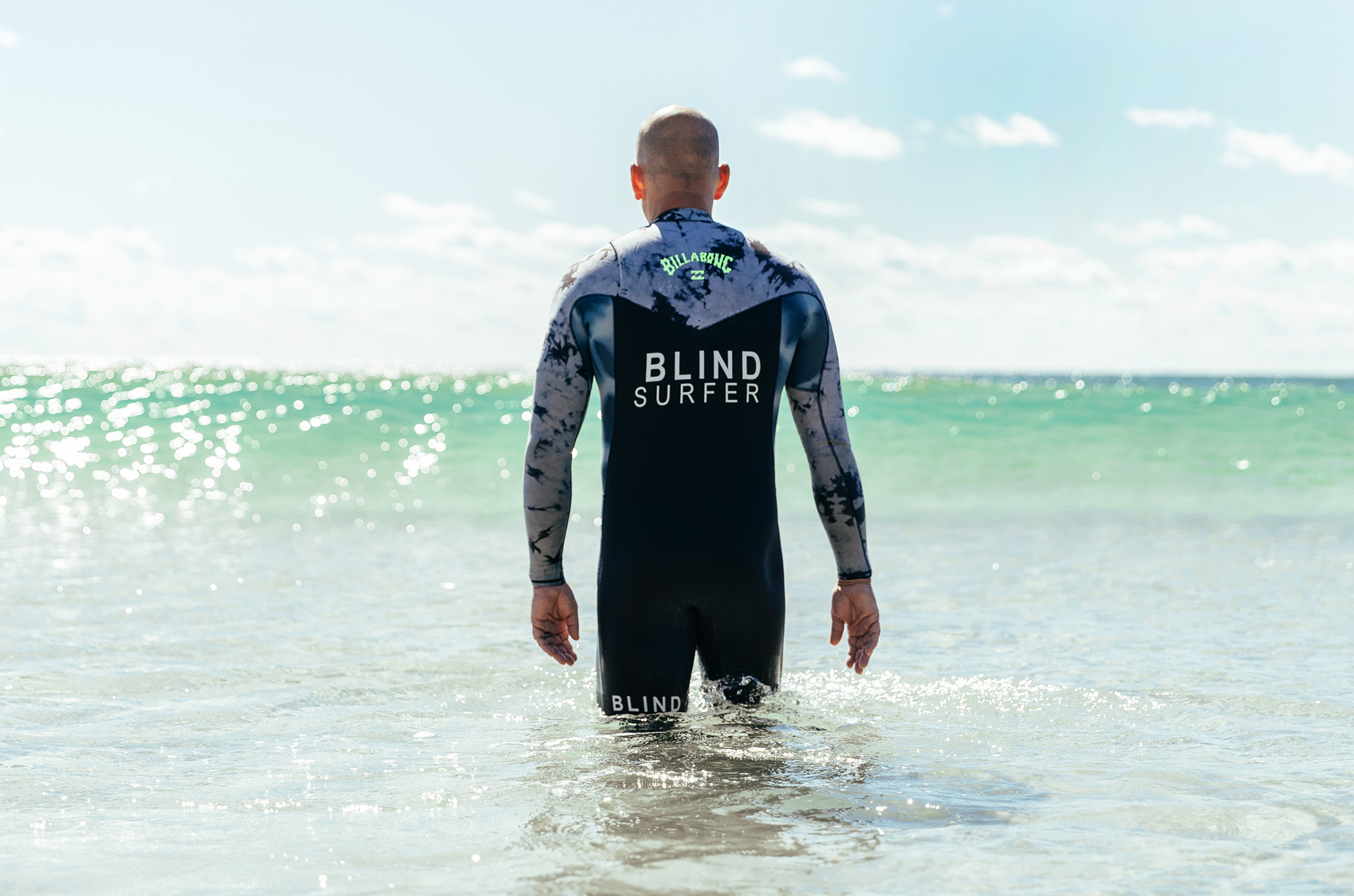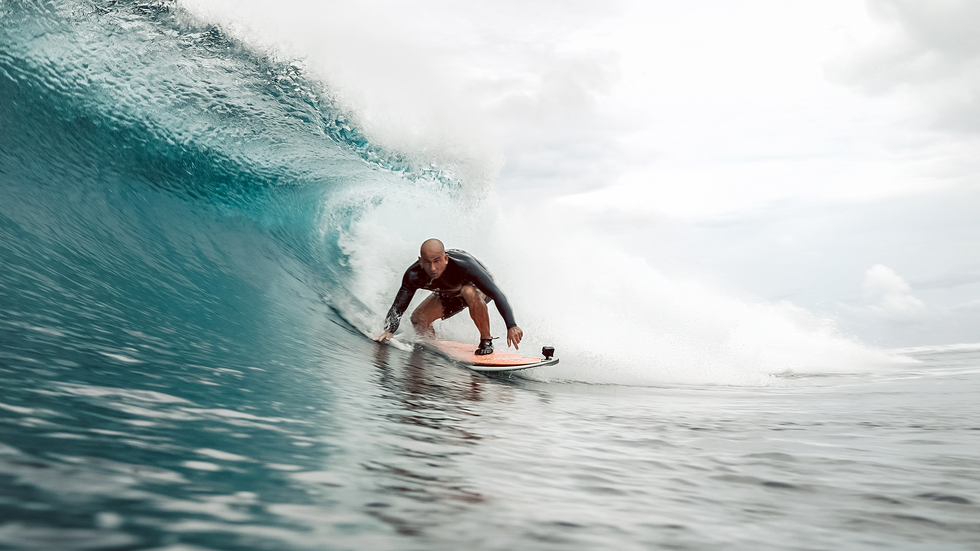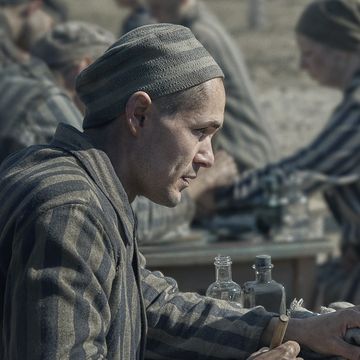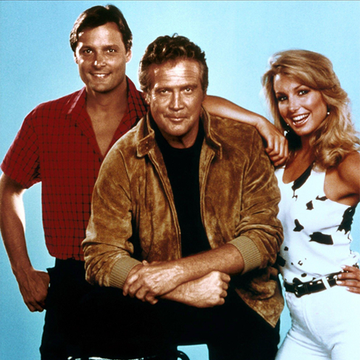Matt Formston has one memory from when he could still see. He’s not completely sure if it’s real, as he must have been very young, maybe three or four. In that one memory, it is Christmas Eve. Formston and his family are at the house of some friends who live on the same street in Narrabeen, a coastal suburb of Sydney, Australia. The dads are messing around, and one of them points to the sky as a shooting star streaks across it and says, “Look, that’s Santa!” The reason Formston thinks it could be a real memory is that the image in his mind is sharp: all the stars are so clear, and then there’s that tiny pinpoint of light moving across the expanse of sky. Maybe a shooting star. Maybe Santa.
Back then he could still catch a ball, and he would look straight at the camera when his parents, Don, a marketing manager for a beer and wine company, and Loraine, a hairdresser, took pictures of him. Not long afterwards, he stopped being able to do both. Formston was diagnosed with macular dystrophy, a genetic disorder that results in a build-up of pigment at the back of the eye. By the age of five, he had lost 95 per cent of his vision. Now, he sees only around the very edges, and in blurs and lines and dots. At the centre of his view, there is nothing.
When they realised their son was going blind, Don and Loraine circled the wagons. This was the 1980s, when ideas about disability were very different, and they were determined that their son should go about his life as normally as possible. To the choruses of “you can’t” that surrounded him, the message at home was “let’s just find a way”. He stayed in mainstream school. He learned to ride a bike; he would navigate by feeling with his foot for the edge of the grass that lined the side of his road. He played rugby union, in the position of “blindside flanker” (now, he says, when he does motivational speaking, that’s his one good joke). He stayed away from the ball, but he was strong, and he knew how to take down a half-back.
One time, when he was a teenager, he was coming home from school on his skateboard, carrying a backpack full of textbooks — he was made to bring them to class each day, even though they weren’t Braille, and he couldn’t read them — when the wheels of his board hit a rock. The heavy bag made him swing around, and he smacked the back of his head against a low brick wall and lost consciousness. When his parents got to the hospital, the doctor informed them that they suspected Formston might have sustained some vision damage, as he couldn’t look at the light. His parents laughed, told the doctor that it was fine, his eyes didn’t work, but could they just make sure his brain was OK? The doctor, incensed that they’d let their son take that kind of risk, stormed out.
Getting around on land, having to memorise every kerb and pothole, was — and is — exhausting for Formston. In the water, though, he felt at ease. Narrabeen is a surf town — it gets a name-check in The Beach Boys’ “Surfin’ USA” — and as Formston was growing up, there were surfers all around him. Damien “The Iceman” Hardman lived on his street, and he used to catch the bus with Nathan “The Hog” Hedge (if there’s one thing surfers love almost as much as the ocean, it’s a terrible nickname). He started boogie-boarding at four or five and switched to surfing at around 10; true to juvenile cliché, it was to impress a girl. When he was surfing with his friends, he felt like he was “one of the boys”. If they were out riding bikes together, he might hit a tree, and they’d be gone. In the surf, if he fell off, he could just paddle back out, same as them. No one would know he was any different.
Formston may not be able to see the waves, but he can feel them. He runs his fingers in the water as it sucks up behind him, listens to hear if it’s drawing into a barrel, senses the steepness through his front foot. But it’s not even as specific as that: it’s something he can’t consciously explain. Call it echolocation, call it proprioception — the sense of your own body in space — but he just knows instinctively how to react to the stimuli around him; he tunes in to what the wave wants to do, and follows its will as best he can. The feeling of gliding, of flying across the surface of the water — that sense of freedom that surfers try so hard, and so in vain, to convey to those who haven’t experienced it — is just as powerful without sight. Perhaps more so.
He was good at it, too. Today, at the age of 44, Formston is one of most celebrated professional para surfers in the world. He has won the ISA World Para Surfing Championship three times, most recently in 2020. He has won the Australian and Hawaiian championships a further four times each, and the US Adaptive Open twice. His excellence in his field is incontestable; his skills as an athlete in no doubt. But if there’s one thing Formston likes, it’s a challenge.
In the Northern Hemisphere, winter is the season of the big wave. This is when the famous breaks at Mavericks in California, Jaws in Hawaii, or Ireland’s Mullaghmore Head gain energy from storm swells in the North Pacific and Atlantic and start to produce waves as high as 50 or 60 feet, which tower over the surfers who are drawn to take them on. There is one wave, though, off the coast of Portugal, which has become the talking point of the scene in the last decade. It is the biggest — some would say, gnarliest — of them all.
In one sense, the wave at Nazaré, an attractive seaside town an hour and a half’s drive north of Lisbon, is also the newest. Not the wave itself of course, which has been there for as long as the Nazaré Canyon: a gigantic 130-mile undersea trench just offshore, which sinks to depths of five kilometres and causes a vast concentration of energy to bore through the water before it rises up, colossally, and breaks below the fort that sits on Nazaré’s rocky headland, or onto the windswept sands of Praia do Norte to the north.
What is new is the notion that you can surf Nazaré, and live to talk about it. Though he was not the first surfer to come here, it was the American pro Garrett McNamara who, in 2010, accepted the invitation of Dino Casimiro, an employee at Nazaré’s city hall, to see what their local break was all about. McNamara couldn’t believe his eyes: a wave so giant and wild that it seemed impossible to ride. Even if you caught one of these monsters, how would you get out of the way before the next one came down on top of you, or the powerful current dashed you on the rocks? He was determined to try.
Because of the size and strength of the waves during an “XL” swell at Nazaré, the only way to tackle them is tow surfing. Pioneered by the likes of American surf legends Laird Hamilton and Buzzy Kerbox in the 1990s, in tow surfing a surfer is pulled along on a rope attached to a jet ski, usually driven by another surfer, who places them at just the right position on the wave, and then swoops in to pick them up after they’ve ridden it. The growth of tow surfing at Nazaré — which is disdained by some purists for its reliance on noisy, petrol-driven machines — was documented in the engrossing 2021 Netflix series 100 Foot Wave, a second series of which is in production.
The wave at Nazaré itself is also contentious: some take issue with the way the water sometimes forms an awkward “teepee” shape that isn’t as aesthetically pleasing as a clean barrel; or with how the sets rear up in a haphazard, unpredictable way and from all kinds of directions. What no one is arguing about, however, is the scale: the official record of the biggest wave ever surfed at Nazaré, by Germany’s Sebastian Steudtner in 2020, was 86 feet. For any ambitious big-wave surfer, Nazaré has become the ultimate test.
In late November last year, I met Formston in the bar of his hillside hotel in Nazaré, which overlooks the marina to the south of the town. The weather was terrible: there was driving rain outside, and as I arrived at the hotel, my trainers squelching, two housekeepers were hopelessly sweeping the shiny front steps with giant squeegees. Formston, who was wearing a black hoodie with the word “yes” written across it and carrying a white cane, which he folded up and tucked away next to him before ordering a beer (“carb-loading”, he quipped), was not unhappy about it, though. “There’s definitely swells coming,” he said. “So there’s opportunities.”
Formston had flown in two days earlier from Australia; he lives in Lennox Head in New South Wales with his British wife Rebecca, an early-years teacher, and their three children. He had come with a small crew from an independent film company, who were making a feature-length documentary about him called The Blind Sea. Nazaré had been on the filming schedule for a while, but the timing of their arrival had proved particularly fortuitous: the second major swell of the season was expected at the end of the week. There was even speculation that the Tow Surfing Challenge 2023 might be announced; because of the unpredictability of weather conditions, it can be scheduled at short notice at any time in the sizeable window between 15 November and 31 March.
All kinds of big names were getting prepared, or flying in to town if they weren’t there already: Brazil’s Lucas “Chumbo” Chianca, who won the men’s Tow Surfing Challenge in 2022; France’s Justine Dupont, the winner of the women’s competition the previous year; Portugal’s António Laureano, who surfed a wave at Nazaré in 2020 that was estimated to have been 101.4 feet, though it is still awaiting official verification by the World Surf League. (The science of measuring wave height is a whole can of worms in itself. As the Portuguese big-wave surfer Nic von Rupp said in a video last year: “It comes to the end of the season and everyone starts pulling out their measuring tape and measuring their dicks. Claims start appearing all over the internet.”)
Formston wasn’t chasing a 100-footer — he might be blind, but he’s not stupid — but he still hoped to get something decent. “I’m not giving you a number,” he said. “I’m catching the biggest wave I can. We’re gonna go out and push it, and we’re gonna push it pretty good.” His focus now was on his training: not how to catch a big wave, but how to survive one if things went wrong. He’d been working on his breathing, and could now hold his breath comfortably for five minutes, though out there it would be different. “When you’re dropping down on a big wave, your heart rate’s elevated, your oxygen’s already depleted and your carbon-dioxide levels are increasing,” he said. “It’s more about managing that, and the disorientation.”
He was being helped in his training by Dylan Longbottom, a 48-year-old former big-wave pro with whom he’d been working since 2019, who has a reputation as one of the foremost board “shapers”: many of Nazaré’s best surfers ride Dylan boards. Longbottom had come over with him from Australia, and on the day we met, the pair had spent the morning at the bottom of the hotel pool, Longbottom holding Formston underwater and throwing him around, to simulate the pummelling he would get if he wipes out (in 100 Foot Wave, the Irish surfer Al Mennie compares falling off a 60-plus-foot wave to “being in a car accident for a solid minute”).
It was Longbottom who first floated the idea that Formston might want to surf Nazaré. As luck would have it — or maybe not — the crew of The Blind Sea were filming at the time, and the documentary’s director, Daniel Fenech, thought the interaction might provide a moment of drama. “I was hoping he might be like, ‘I don’t know, let me think about it,’ Fenech told me. “But the whole time we were dropping this on him, his smile got bigger and bigger. It was like, ‘Oh shit, what have we done. We’ve unleashed the beast.’”
Longbottom knows all too well the risks of their sport; his older brother, Darren, was left a quadriplegic by a surfing accident in Indonesia in 2008. For Formston, the main consideration before saying yes was his wife and family. He’d been away a lot that year, competing and filming in other parts of Australia and in Fiji, Hawaii and Indonesia. While his two youngest children, Elsie, aged seven, and Jake, four, didn’t really know what he was planning to do, his eldest, Max, who is eight and already a good surfer himself, knew exactly what Nazaré was. “You can’t, Dad, you’ll die,” was his response.
Rebecca, he said, is “forever supportive”, and gave him her blessing. “And once my wife gave me the OK, I couldn’t wait to get here.” Before that, though, she had a blunt discussion with his mum. “I probably shouldn’t tell you this,” he said, “But the summary of the conversation was that they felt it would be a better outcome if I died than if I come home as a vegetable.”
Still, Formston wasn’t getting ahead of himself. “I’m not going to rush into it just because I’m excited,” he said. The conditions had to be right — and right for him — and there was work to do.
The next day, Wednesday, I join Formston at the marina, where the equipment is being readied. The hope is that Formston and Longbottom will head out on a jet ski later that afternoon because, as Daniel Fenech puts it, “Matt needs to feel how the water moves.” The guys I had met yesterday on dry land, who looked like what they were — middle-aged men in sportswear — are hoicking on black wetsuits and transforming, selkie-like, into sleek creatures of the sea. I catch a glimpse of the tattoos on Formston’s back: three manta rays, representing him and his parents; an inked octopus encircling his right bicep.
Whereas most surfers can look down the face of a wave and decide whether or not they want to surf it, Formston does not have that luxury. It will be up to his team to pick the wave for him, and give him the signal. Earlier that morning, they had bought orienteering whistles, which will provide Formston’s cue: one blow for “go”, two for “turn”. There will be no room for error once they’re out there, he explains: “If somebody yells, ‘Go, go,’ it could be ‘No, no’. We don’t want to miscommunicate in this situation.” (Longbottom, who may well be on whistle duty, is suitably calm about the prospect. “It’s a big responsibility, but I’ve been doing this a long time,” he says, “I take my daughter, who’s 19 now, out on big waves, and that’s an even bigger responsibility.”)
Formston shows me the board he’ll be riding, shaped by Longbottom and borrowed from Lucas “Chumbo” Chianca: it is heavier and shorter than a traditional surfboard, because it need to cut into the face of the wave, not just skim across it, in order to hold him in the water when he’s travelling at speeds of 50 or 60 kmph. He’ll have on an “evacsuit” made by one of his sponsors, Billabong, which has high-density foam blocks around the legs and chest for flotation, and four cannisters of compressed carbon dioxide on his back. If he finds himself under the water for a dangerous amount of time, he can deploy them, “and I’ll just pop to the surface”. His faith in his system is close to absolute. “Even if I do catch a really big wave on the head, and I go down, and I can’t hold my breath for long enough, the guys are gonna get me out and resuscitate me.”
It all seems quite foreboding — except for a moment when Formston, yanking his evacsuit over his wetsuit, accidentally pulls two of the CO2-cannister tabs and his back inflates like a turtle shell (“Looking a little chonky there, Matty,” says the ocean cinematographer, Ben Bagley) — but this, Formston assures me, is what he enjoys. “I don’t think most people who know me well would say that I’m, you know, a larrikin. I’m a very intense, serious person. This is my fun.”
He does appear to relish all the forensic planning, all the protocols and gizmos that mean he might be less likely to — let’s be frank — die. “Technically, everything is as broken down as it can be; every little piece of the project has been considered. When you do that, it takes away a lot of the fear because you understand what you are actually undertaking and what the real risks are,” he says. “People talk about death, and it’s quite morbid, but I’ve got my team, I’ve done the training. I don’t think that’s a reality for me.” (A few months after we meet, in January 2023, Nazaré claimed its first victim: the veteran Brazilian surfer Marco Freire, 47, who died while tow surfing at Praia do Norte.)
Formston’s mum and dad like to say that he was “born without a self-preservation gene”. He uses the word “sociopathic” — calmly, like a good sociopath would — to describe his lack of terror in the face of what he’s planning to do. “I’m black and white. I’m doing this or I’m not. Like, when people talk about fear, I sort of understand it, but I don’t really understand it. I think what most people are afraid of is the bogeyman: the person in the dark they can’t see, the thing that doesn’t seem possible. In my life, there have always been people who say ‘You can’t do this.’ But for me, if I’ve made the commitment, I do it.”
He’s also aware that his opportunities aren’t endless. “I’m not that young anymore. I’ve got a couple more years to push the limits,” he says. He didn’t get started in elite surfing as early as he might have, and was already 38 when he competed in his first world championship. “I was just broken by all the things that had happened to me in my teens. But I think that also gives me the strength: knowing what I went through. Now, surfing a massive wave doesn’t feel like that much of a challenge.”
For all Don and Loraine’s attempts to shower their son with validating messages, in adolescence the outside world came crashing in. School was the hardest thing for Formston. Not the work, which he was decent at, but the “weakling bullies” who targeted him. Formston’s reaction was to fight back, driven by the desire to prove that he could overcome anyone physically. But with the satisfaction of having won — which, he says, he always did — came the self-loathing of having hurt people, deservedly or not.
His drive to prove to other people that he didn’t have a disability was all-consuming to the point of recklessness. When he and his friends would climb the huge eucalyptus tree across the street from his house, Formston would make a point of climbing higher than the others. He didn’t want to be disabled: he was embarrassed by it, and it made him angry. He was ashamed that when he met girls, he couldn’t look them in the eyes.
As he grew older, his behaviour got worse: by his twenties, he was partying hard, fighting, and was lucky, he says, not to have ended up dead or in jail. He struggled in his relationships with women — maybe it was because of who he chose, maybe it was because of who he was — and gave up all of the sports at which he excelled (except surfing; there was always surfing). Things in his life had gotten, he had to admit to himself, “really bad”.
Then one day in 2009, while riding the bus with a friend — a colleague at Optus, a telecommunications company where Formston still works, which is also his main sponsor — the friend mentioned that he was planning to cycle from Sydney to Melbourne. Formston responded, “I’ll come with you.” He ended up completing the solo bike ride — all 1,200km of it — which prompted Cycling Australia, the national governing body for the sport, to take note. He was invited to try tandem cycling, for which he’d be paired with a sighted pilot. By 2014, he and his partner Mick Curran held the world record in the 4000m tandem individual pursuit; by 2016, he was competing at the Paralympics in Rio.
Suddenly, all the other areas of his life seemed to be coming together, too. He was promoted at work; he is now Optus’s head of sustainability. He met Rebecca. Something in his psychology had shifted. He started reframing his ambition so that it wasn’t about taking down other people, or proving he wasn’t disabled. It was about pushing himself on his own terms, seeing what he was capable of as a human. A voice in his head told him, “I need to do this for me, and I need to do it now.”
But despite his success on a bike, he never loved cycling. The training required — six hours a day — meant he didn’t have time to surf, plus with sponsors paying him to travel around the world to compete, he couldn’t risk even a minor injury from surfing, such as a fin-chop from his board. Twice a year though, in late September and early April, he would get two weeks off, and in that time he would surf. It wasn’t as much as he’d have liked though, and it meant that, when he got back from Rio (where his highest placing was coming fifth in the men’s 4000m individual pursuit) and entered the Para Surf Championships, he was “a bit rusty”. He came third.
Formston doesn’t have a nemesis, he says, because if you have a nemesis it means you’re too caught up in what other people are doing. He’s not actually the first blind surfer to come to Nazaré: the Brazilian Derek Rabelo went in 2017, though when I bring him up, Formston says he doesn’t know how Rabelo fared, but thinks he did “pretty good” (again, records are patchy, but the reports are 15 feet). In fact, he says, with a flash of the old ruthlessness, the pair of them have never met: “I think he did one competition and came 11th or something, so he didn’t come back”.
Surfing Nazaré is a personal thing, more or less; it’s just about beating himself. And the monster waves, of course. Let’s not forget about them.
The storm arrives on Thursday. The sky is dull and mizzly, but for a time in the afternoon, it clears. From the window of my hotel room in the touristy part of town near the main beach — the calmer, family-friendly Praia da Nazaré —I can see the funicular train cars sliding up and down the hillside, and the minuscule figures starting to make their way up the stairway that snakes up to the headland, like a line of leafcutter ants.
On the top of the headland a little later, the atmosphere is like an ad hoc festival. There are food trucks and tuk-tuks ferrying people up and down to the 16th-century fort, past a more recent Nazaré landmark: a looming 20ft statue of a stag-headed surfer, erected in 2016. Small groups of young people sit on rocks on the hillside, smoking weed and gazing blissfully out to sea.
At first, it’s the waves themselves that are the spectacle: they heave impossibly into the air, and break with a roar into thunderous clouds of white foam. But by mid-afternoon the first jet skis appear. They’re no more than small black dots, carving lines in the water as they assess the conditions. Perhaps it’s because I’ve seen the posters in town, but they make me think of the cavaleiros of a Portuguese bullfight: the riders on horseback who stab the bull with their pointed bandarilhas, to provoke him into showing them what he’s got. Although perhaps the metaphor is a dud one: at Nazaré there are multiple bulls, and it’s not clear who is coming for whom. (As Al Mennie put it in 100 Foot Wave, describing his first time on the water here: “This was like a war zone, peaks and waves coming in from every angle. It felt like you were being hunted.”)
At 3.45pm, the first wave is caught. Cheers erupt from the now hundreds of people gathered on the headland and leaning, somewhat perilously, over the walls of the fort, as a figure on a board appears, carving a thin white incision across a huge curling wave, and kicks out just in time. Then the frenzy begins. Every few minutes, another surfer catches an enormous wave to cries from the crowd; at one moment, a small figure finishes a ride with an elaborate flourish of two overhead spins; at the next, a surfer has fallen, and is being pounded towards the rocks, the crowd calling out and pointing towards his tiny arm waving from the water, before a jet ski spots him and zooms in.
I turn to my left and there, right next to me, are Formston and Longbottom, in their civvies again, and also facing out to sea. “Did you see Lucas do the double flip and then go in for that jet-ski rescue right after?” says Formston. I tell him that I hadn’t known it was Chianca out there, but that, yes, I’d seen him do both, without thinking until later that Formston himself had not.
But Formston’s time is coming. The wind is too strong on Friday, but on Saturday, he surfs. The waves are decent by normal standards, modest for Nazaré. He surfs again on Sunday, though they’re a bit smaller. Still fun, and he feels good. Monday he’s out again, but the day is marred by an incident in which Longbottom comes off on a bumpy wave and is gashed on the back of his head by his board, requiring a hospital trip and 12 stitches. The next day, Formston will be flying to California for the Para Surfing Championship at Pismo Beach, but he can probably fit in one more session in the morning before he heads to the airport. At least he can say he’s surfed here, and tick it off his list.
On Tuesday, his final day, the conditions are perfect. It’s sunny, the sky is bright blue, and there’s a light wind coming off the land. The waves are bigger now and clean and, as he catches a couple of larger ones, the excitement in Formston’s team starts to build. Chianca, who is driving the jet ski for him since Longbottom’s accident, spots a wave that he thinks has potential, so he takes them out towards the horizon to get round the back of it. Formston feels the lift and fall as they go over the top. It hasn’t broken yet, but it feels steep, like a big body of water. A big lump. He hears Longbottom, on another jet ski, say something that sounds like, “Oh my God.” Then he feels Chianca rev their own jet ski, and the rope tightens as they start to gather speed.
Later, there will be whoops, and screams. There will be talk of 50 feet, maybe even more. There’ll be images shared on social media and interviews on the news. A tiny dark shape moving across the expanse of water. But right now, there is nothing else. He can’t look down to see what’s coming. He can’t get scared, the way the others are scared on his behalf. If they make the call for him to surf it, he won’t know how big it is until he gets to the bottom. His body is alert, ready to feel what the water wants to do. His brain has shut down. He doesn’t hear anything; he doesn’t need to. The shouting of his team, the jet skis, the other waves breaking nearby: he filters them all out. He hears only a single blow of the whistle. And then he lets go. ○
‘The Blind Sea’ is out in late 2023

Miranda Collinge is the Deputy Editor of Esquire, overseeing editorial commissioning for the brand. With a background in arts and entertainment journalism, she also writes widely herself, on topics ranging from Instagram fish to psychedelic supper clubs, and has written numerous cover profiles for the magazine including Cillian Murphy, Rami Malek and Tom Hardy.
